By Jeffrey A. Rendall, Photos By Kevin Gaydosh
KIAWAH ISLAND, SC – Kiawah Island Golf Resort is known for many things, probably the most notable being its hosting of the 1991 Ryder Cup matches – the famous ‘War by the Shore,’ where the United States Team dramatically captured the Cup when European Team member Bernhard Langer missed a short putt on the final hole of the final match to ‘give’ the Americans the victory.
But even without its impressive professional golf past to bolster it, Kiawah Island features one of the best ‘lineups’ of golf architectural talent you’ll find anywhere. The resort offers its guests the opportunity to play layouts designed by Pete Dye (Ocean), Jack Nicklaus (Turtle Point), Clyde Johnston (Oak Point), Gary Player (Cougar Point) and last but not least, Tom Fazio (Osprey Point).
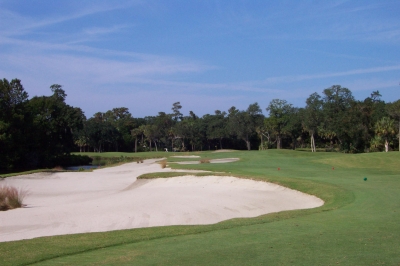 |
| Thankfully, most of this huge bunker isn't in play on the long par three 6th hole (201 yards) -- but you get an idea of the amount of sand that's prevalent at Osprey Point. |
That’s a remarkable collection of design aptitude right there, and any one of those names brings instant credibility to your golf offerings, let alone all five. And the best part about it, the golf courses these gentlemen designed for the resort are all very different.
“I think Osprey Point gives the golfer a great sense of open-space, and when combined with all the other different golf courses at Kiawah Island, adds up to quite a unique collection of golf that few places can offer,” Fazio said. “Obviously Osprey isn’t on the ocean or in the dunes, but it also has its own unique personality – so I think it blends very well with the diverse golf on the entire island.”
We’ll touch on the other courses in separate reviews – but Fazio’s right. Osprey Point is set apart from all the others. It was the third course built on Kiawah Island (opened in 1988, after Cougar Point and Turtle Point), and you’ll realize right away that the parameters must’ve been different when they brought in Fazio to lay out this course – it’s much more ‘open,’ and a lot wider than the others, too.
Osprey was built when the Kuwaitis still owned the island, and was placed in an area where there’d been very little previous development – so Fazio had a bit more leeway in making design decisions. The result was a development golf course with a plethora of natural environmental vistas and wide set-backs from the houses. You’ll certainly know at all times that you’re playing amidst a residential area, but there’s very little ‘human’ intrusion on the golf experience, at least.
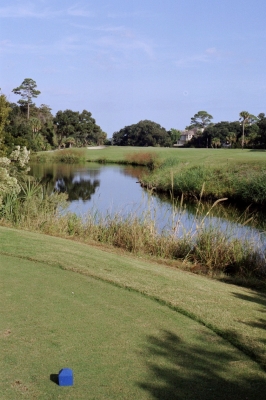 |
| The view from Osprey's 16th tee -- a bit of water to carry, but plenty of green space waiting to receive the ball. |
Fazio describes it: “In those days, Osprey Point was quite a distance from the existing development on the island. Because of that, we had a lot of space, and a whole new forest to work with. It was pretty much a combination of land planning for residential and golf – it wasn’t just strictly a residential golf course, though that was certainly a major part of the preparation.”
He continues, “As you can see from the clubhouse and the routing, there’s a major core space area between the clubhouse, the first hole, ninth hole, practice range, tenth hole, a big lagoon/marsh area, and then the eighteenth hole. So, there’s a really great, wonderful expanse of golf.”
“And then the golf course itself -- with the front nine meandering through the forests and around marshes and lagoons and traverses kind of a long distance, then loops back along a lagoon that also parallels the first hole. The back nine does a similar kind of meandering on the east side of the property,” Fazio explained.
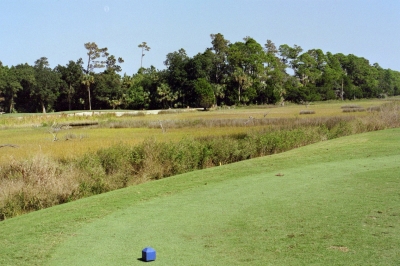 |
| The par three 3rd hole's a good example of the 'wild' feel of Osprey Point, despite its being part of a residential area. |
Sounds like a lot of looping, but as you’d come to expect from a Tom Fazio designed golf course, it’s a dramatic journey along the way – and we’re not just talking about the golf. There’re lots of water and marsh views to gaze at and play over and around, and we saw a good share more waterfowl and wildlife (gators) than we did on all the other courses.
Osprey Point was kind of ‘wild,’ despite having all the homes around it – hard to imagine what it must’ve been like when it was first built.
Osprey’s Head Professional, Jim Kelechi, said the course was so far removed that they used to take a golf cart from Turtle Point and ‘poach’ some golf holes over at Osprey before it opened. He said there were only about three homes along the fairways in those days, which made it easy to enjoy Osprey’s natural gifts in a nearly private, pristine setting.
It was also because the course sat for a while in a near-finished condition prior to opening.
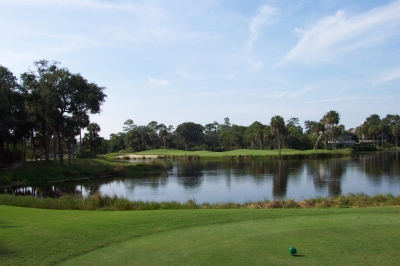 |
| The location of the pin on the par three 11th hole's huge green, along with the direction of the wind will play havoc with club selection from the tee. |
“The ownership situation at that time was going through some changes, so the decision was made to delay opening the new Osprey Point course, even though it was for all intents and purposes, ready to play,” Kelechi said. “We had a skeleton crew of three or four guys taking care of the maintenance, and it just sat there invitingly – so we took advantage of that on a few occasions.”
Again, though the borders are completely developed in 2005, a lot of the ‘original’ inhabitants remain, namely the alligators. You’ll see some on all of the Kiawah courses, but with Osprey being the most ‘natural’ (except for maybe the Ocean Course), the toothy reptiles seem to be everywhere.
Some debate raged between the members of our party as to just how dangerous the gators are to us bipedal visitors, so Kelechi solved the mystery for us: “We get a lot of comments about the wildlife at Osprey, especially the gators. They’re basically harmless and will run the other way when approached, most of the time. The biggest problem is when somebody starts feeding ‘em. When they start associating humans with food, that’s when they need to be relocated elsewhere.”
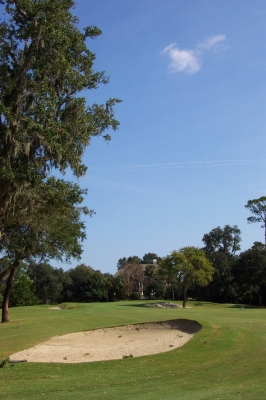 |
| Turning the corner on the par five 8th hole. |
Kelechi helped answer another lingering question about Osprey and Kiawah in general – what happens to the thousands of golf balls that find their way to the amply available water hazards? If there are all those alligators in the water, do the balls just pile up on the lagoon floors?
Nope.
“We have a company that comes in to get the golf balls, and divers go in the water, gators and all. The gators don’t like messing with anything as large as a human being, so it’s rare that there’re any ‘close encounters.’ I talked to a diver who’s done it, and he said the only time he’s ever had a problem was when he accidentally stepped on one, on the bottom of a pond, and it bit him,” Kelechi chuckled.
There was another incident where a gator tried to climb on the back of a kneeling diver, while gathering golf balls – but as soon as the mistaken identity of climb-or and climb-ee was realized, both the diver and gator headed in opposite directions, scared off in both cases.
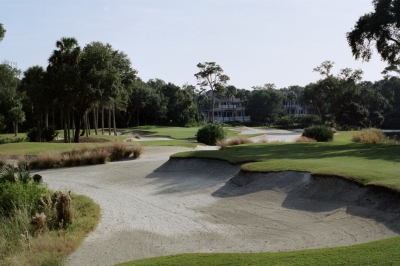 |
| The par three 15th hole, one of the most beautiful sights on all of Kiawah Island. |
Back to golf.
Just because of the course’s natural beauty and relative open feeling, don’t get the impression that it plays easy, or more appropriately -- passive. Tom Fazio’s courses are always spectacular to look at and fun to play, mainly because they’re so wide – but if you head to the back tees, you’ll get all the challenge you’d like.
“There aren’t a lot of forced carries on this course – a couple on the par threes – but there’s lots of lateral trouble out there, in the form of ponds and marshes,” Kelechi said. “So if you tend to hook or slice the ball, you can find it because there’s a lot of water on this course.”
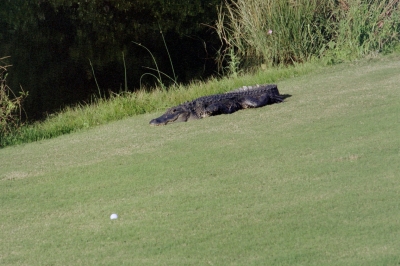 |
| An alligator looks on as one of our foursome's tee shot landed just feet from it. In case you're wondering, we gave him a free drop a safe distance away. |
There’s also a lot of sand. “We call it ‘dramatic bunkering,’” Fazio explained, “because the bunkers also become environmental areas for protection – to prevent and filter run-off, as well as help out with draining the course. The sand buffers the edges of the golf course. It keeps the golfer focused to some degree away from the edges, and also makes the golf course not quite as hard.”
“It also adds some drama and ‘framing’ definition to each one of the golf holes,” Fazio added.
A final note before looking at a few of the highlight holes – Osprey Point underwent a minor renovation in the late nineties. Fazio said it’s always good to come back in and touch up things after a period of time – especially to a golf course that’s endured hurricane seasons and the building of a complete residential development around it.
“A golf course always changes over time, so it’s good to come back in and give it a bit of a facelift. At Osprey Point, we didn’t change things substantially,” Fazio explained. “We added some trees where we’d lost some, and replaced some other vegetation. Because of the growth of some of the trees since the course opened, it started influencing play, so that had to be addressed. Then the bunkers always need some work as well. It was a lot of little things that most people wouldn’t even notice.”
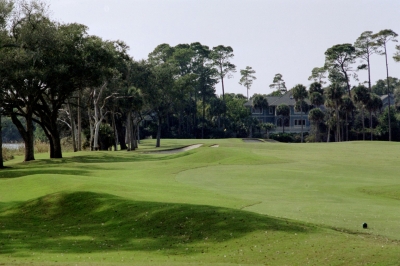 |
| The 10th hole is part of that great expanse of open-space Tom Fazio was talking about. |
Hole highlights include the third hole, a 175-yard par three (from the gold tees) with a nearly full carry over a marsh area. If you can block out the carry the hole’s not difficult, as there’s more than enough landing area on the other side.
The ninth hole is a classic for beauty as well as playing characteristics. From the back sets of tees (461-yard par four), there’s a carry over a lagoon to an extremely wide landing area, protected by a bunker in the middle. If you risk it left of the bunker (a slight dogleg left), you’ll cut off a lot of yardage on your second shot. It’s safer to the right, but that’ll make the approach quite a bit more difficult. Choose your poison!
There’s also a large Osprey nest in the trees near the ninth green – a wonderful natural feature.
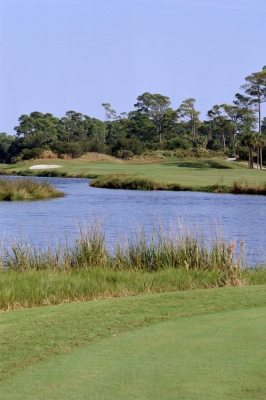 |
| The 9th hole is one of the most interesting, challenging and scenic golf holes in all of the Kiawah Island experience. There's plenty of room to the right, but cut off as much distance as your driver will allow. |
On the back nine, the eleventh hole is another good par three requiring a carry over a lake. The green is huge – Kelechi said it’s about 75-yards from front to back, so the hole plays quite a bit differently depending on pin position and the wind. This area of the course is very open, so any prevailing breeze will definitely make a difference.
The final hole is a fitting end to the Osprey Point journey. It’s a 552-yard, risk-reward par five. Again, it’s very generous off the tee, with trouble down the left side if you hook it too much. If you had a big drive (and the wind’s right), you might be able to reach the green in two, but there’s ample trouble in the form of bunkers and water, again on the left side, if you fail to hit your target.
According to our playing partners, Osprey Point is probably the favorite course of Kiawah’s resident members, and we can easily see why. It’s ‘wild,’ open, and challenging enough to make the course different everyday – as much a member’s course as it is a resort course.
We’d expect nothing less from Mr. Tom Fazio, and he’s delivered once again.
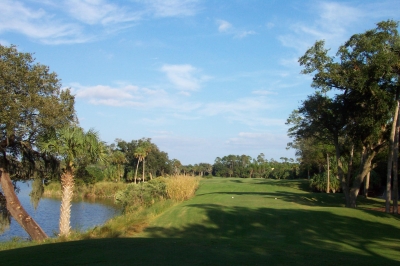 |
| Going towards home on the tee of the par five 18th hole. |
Note: Check the links below for reviews of the other courses at Kiawah Island Golf Resort, as well as a preview of the accommodations.
Details:
Osprey Point at
Phone: (843) 768-2121
FAX: (843) 768-6093
Website: www.kiawahgolf.com
The Sanctuary’s Website: www.thesanctuary.com
Course Designer: Tom Fazio
Director of Golf: Roger Warren, PGA
Head Golf Professional: Jim Kelechi, PGA
Superintendent: Steve Miller
Tees/Yardage/Slope/Rating
Gold 6871 137/72.9
Blue 6602 128/71.0
White 6311 119/68.8
Green 5593 112/66.7 130/73.2 (L)
Red 5023 121/70.0
Rates:
Package rates for
The Championship Golf Package
Enjoy your choice of accommodations — in a luxurious oceanview guest room at The Sanctuary or in a one-bedroom scenic villa — plus one round on the world-renowned Ocean Course and two rounds at any of the resort’s other championship courses. Green fees, cart fees, range balls, daily breakfast and dinner at any resort restaurant are also included.
Sanctuary Championship Golf Package Rates
(Per person, per night for two people staying in an oceanview room. Single rates available.)
March 9 – May 31 . . . . . . . . . . . . From $540
June 1 – September 6 . . . . . . . . . From $468
September 7 – November 29 . . . . .From $529
November 29 – February 7, 2006 . .From $393
Villa Championship Golf Package Rates
(Per person, per night for two people staying in a one-bedroom scenic villa. Single rates available.)
March 9 – May 31 . . . . . . . . . . . . From $429
June 1 – September 6 . . . . . . . . . From $383
September 7 – November 29 . . . . From $423
November 29 – February 7, 2006 . .From $303
The Classic Golf Package
Enjoy your choice of accommodations — in a luxurious oceanview guest room at The Sanctuary or in a one-bedroom scenic villa — and one golf round per night's stay at any of the following four championship golf courses: Osprey Point,Turtle Point, Cougar Point and Oak Point. Green fees, cart fees, range balls and daily breakfast are also included.
Sanctuary Classic Golf Package Rates
(Per person, per night for two people staying in an oceanview room. Single rates available.)
March 9 – May 31 . . . . . . . . . . . . From $395
June 1 – September 6 . . . . . . . . . From $328
September 7 – November 29 . . . . .From $362
November 29 – February 7, 2006 . .From $260
Villa Classic Golf Package Rates
(Per person, per night for two people staying in a one-bedroom scenic villa. Single rates available.)
March 9 – May 31 . . . . . . . . . . . . .From $261
June 1 – September 6 . . . . . . . . . .From $241
September 7 – November 29. . . . . .From $254
November 29 - February 7, 2006. . .From $169
For additional information or to make reservations, call or click: 800.654.2924 • www.kiawahresort.com. For groups of 12 or more, call our group golf specialist: 800.576.1585.
| Related Links | Comments on this article? | |
|
Maryland National Golf Club Hollow Creek Golf Club Rocky Gap Resort PB Dye Golf Club in Ijamsville Whiskey Creek Golf Club |
E-mail Jeff Rendall, Editor: jrendall@golftheunitedstates.com |











